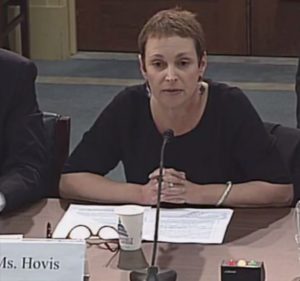On March 21, CLIC CEO Joanne Hovis testified before the House Subcommittee on Communications and Technology in strong support of inclusion of broadband in federal infrastructure funding. Joanne also advocated for federal policy to support broadband public-private partnerships as a mechanism to enable and expand broadband deployment, particularly in rural areas. We have provided excerpts of her testimony below and her full testimony can be found here.
An archived video of the hearing can be found here.
——————-
My name is Joanne Hovis. I am the president of CTC Technology & Energy and CEO and co-founder of the Coalition for Local Internet Choice …
I make the case today for including broadband, particularly in rural areas, among the infrastructure categories in any infrastructure investment program, and recommend particular public-private partnership and related mechanisms that can be included to increase the likelihood of the necessary capital flowing to the areas with the greatest needs….
Broadband Gaps Align with Lower Income Levels and Lower Population Densities — These Are the Areas that Would Benefit Most From Broadband P3s
Broadband, like any other type of infrastructure, requires significant upfront capital for deployment of networks and services, and private capital will flow to areas where potential return is highest. In a number of densely-populated, higher-income areas, incumbent phone and cable companies have upgraded their networks to enable new services and high-speed internet access. A handful of these areas have also seen investments by new entrants seeking to outflank the incumbents in establishing 21st century broadband infrastructure.
In contrast, in less densely-populated areas and lower-income areas, the pace of progress has been much slower. Offering lower returns on private investment, these areas have seen their economies stagnate, their children move to more promising locations, their hopes for a better future ebb away. Fortunately, P3s and other collaborative public-private structures offer one promising solution.
Broadband Public-Private Partnerships Present Opportunities for Economic Benefit in Rural and Low-Income Ameria
State and local governments are increasingly motivated to incent private sector investment in next generation broadband networks,… with the public entity building the infrastructure but uninvolved in the private sector role of operations and service delivery to the public. Alternatively, the state or locality can partner with the private sector for shared investment in private networks that secure public sector goals (such as service in rural areas that seek to maintain economic viability and enable such critical practices as home-based business and home-schooling)….
Recommendations
Even a combination of tax credits and P3s alone would be insufficient to attract investment to rural areas. All things being equal, investors will go to where the market is strongest, the returns are highest, and the revenues are likely to be most robust.
As a result, unless tax credits are geographically targeted, investors will not generally take the tax credits to rural parts of the country. Instead, investors will likely use the tax credits in markets, including through P3s, where the potential for substantial revenues is greatest – well-to-do, densely-populated areas….
For this reason, based on my experience, I suggest that the strategies include some of the following recommendations to make the tax credits and P3s in rural areas more viable and more attractive to investors:
–>Create financing support mechanism to reduce P3 borrowing costs… thus making the P3s more viable at modest cost to the treasury
–>Enable use of tax-free municipal bonds to fund public infrastructure in P3 environments or for lease to private ISPs thus reducing municipal borrowing costs, enabling P3s, and increasing project viability at modest cost;
–>Enable transferability of tax benefits such that non-profits and public entities can sell tax credits or other tax opportunities on the market—thus making tax mechanisms more viable for areas that are of less interest for private capital;
–>Carve out funding and other support for areas where the local economy has been impaired by technology change and globalization—and where broadband could have a disproportionate impact (relative to cost) on improving economic opportunity;
–>Include Dig Once and construction efficiency strategies in other P3 projects, in order to capitalize on opportunities presented by construction in the rights-of-way
